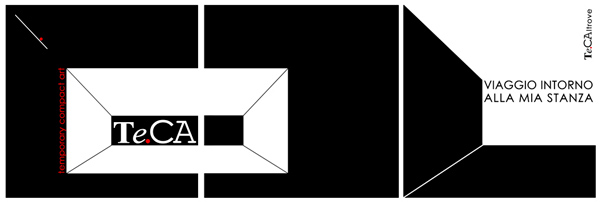
Journey around my room in Te.CAltrove Digital migration of the micro-gallery Te.CA_TemporaryCompactArt
The SARS-CoV-2 virus marks the fulfillment of a prophecy of the pandemic explosion and annihilates the certainties that supported our vision of the world. It has been constructed a dimension that forces us to confront the unknown and changes the perception of the world as guardian of the history, a familiar space subjected to the control of homo sapiens, compared to an unknown for centuries postponed to somewhere else.Instead, the atmosphere of suspension triggered by the virus marks an importantmoment in the history that imposenew points of view, derived from the awareness of the human vulnerability. Therefore, it has been acquired that «our future isn’t directed by historical progress» (Morin 2000), nor by economic engineering or by the criteria of efficiency or the free market, imposing a dialogue with the uncertainty of the future. More precisely, this kind of condition requires an un expected necessity of knowledge and curiosity that during the lockdown led to a surge in digital visits to museums and art spaces.
Virtual tours, open collections, digital exhibitions, guided tours, live streaming, each cultural reality has increased digital services by re-delineation the perception of the art and relationships with the cultural proximity.
Thus, Te.CAltrove is part of this framework, digital relocation of Te.CA_TemporaryCompactArt, the gallery envisioned by Gianfranco Neri in the dArTe Department at the Mediterranea University of Reggio Calabria. Te.CA is micro exhibition space with dimensions of 32x55x23cm, perhaps the smallest ever, carved in a wall that is positionedin a transit area at the university, space in-between microcosm and macrocosm where since 2016 have been organized exhibitions and meetings. During the lockdown, the gallery proposed the digital exhibition Journey around my room, a moment of reflection on the pandemic as an opportunity to rethink our "humanity."
Architects, artists, designers were invited to participate and share their experience of staleness – as an action of dwelling in place – trying to trace a surveybetween multiple definitions of inhabiting the domestic space and narrating that disjointed landscape that in prophetic scenarios of the globalized metropolis was dissolving into progressively shared and fluid spaces. The works presented each week on the gallery website try to understand how much the current pandemic condition leads on renaming the areas of our daily life, the relationship between physical and virtual, our own way of living and interacting with nature, forcing us to rethink the concept of privacy and the border between inside and outside that was gradually dissolving.
Gianpiero Frassinelli opened Te.CAltrove re -proposing the City 2000.t.(1971) by Superstudio, montage of cells with permeable walls, in which a receiving screen transmits brain impulses to an electronic analyzer, a prophetic vision that control the desires of individuals that aspired to equality conditions. The collages of Carmelo Baglivo are deeply related to this imagery as well as the panoptic device designed by the Analogique team is linked to this imaginary, which emphasizes the contradictions between the safety of collective health and the protection of individual data.
Another journey is Stanze della casa di me of BeniaminoServino and the collages of Luca Galofaro who during the lockdown continues to travel dwelling the home, materializing stratified memories through the manipulation of the images of his archive.
Desks as workshops of thoughts are those of Carmen Andriani, Maria Luisa Frisa, Gianluca Peluffo shots as well as Luca Molinari's Fragile Room, where the objects and the books are like the soundtrack notes that try to tune in with the outside world.
The protagonists of the theater-box from Gianfranco Neri are entities that draw trajectories of meaning starting from their forms, materials in which the reflection in the mirror places us on the backdrop, de-situating us directly on the scene.
The house as a small town, proposed by Enrico Prandi, put the accent on the externality of the interior, while Ottavio Amaro designs a domestic microcosm, inspired by the interiors of Vermeer, the house as a treasure chest of memories, fortress and monastic cell, where the search for individual enclosures reflects on the relationship between interior-exterior and the condition of free space. Enclosures broken by the materialized light of Chiara Coccorese bursts into the domestic space creating dynamic vortices.
Carlo Prati's drawings also offer a reflection on dwelling as a result of the mutilation of the public sphere, his Lost Horizons reveal a dystopian scenario that aspires to a renegotiation of the relationship between architecture and nature. While the artist Barbara Cammarata refers to the link between our existence and the natural laws, portraying the mutation of the human and animal species.
Therefore, 23 micro-installations construct a permanent digital exhibition reinforcing the idea of the Te.CA gallery, providing a multifaceted space for reflection through art as an everyday experience, particularly in context of the university increasingly subjected to adaptive overpressure to economic and technical questions.
Marina Tornatora
List of Invited: Gian Piero FRASSINELLI, Beniamino SERVINO, Carmelo BAGLIVO, Efisio PITZALIS, Carmen ANDRIANI, Carlo PRATI, Maria Luisa FRISA, Luca GALOFARO, Enzo CALABRESE , Gianluca PELUFFO, Gianfranco NERI, Chiara COCCORESE, Ottavio AMARO, SasoPIPPIA, Dory ZARD, Barbara CAMMARATA, ANALOGIQUE, Francesco SCIALÒ, Antonello MONACO, Luca MOLINARI, Jorge Cruz PINTO, Ruggero LENCI, Enrico PRANDI.
Concept and edited: Marina Tornatora
Scientific Committee: G. NERI, O. AMARO, E. ROCCA, M. TORNATORA
Editorial Coordinator: F. SCHEPIS
Research team: R. E. ADAMO | M. BAGNATO | B. BAJKOVSKI | A. DE LUCA
Te.CAltrove, digital gallery of the dArTe Department – Mediterranea University of Reggio Calabria
Link: https://sites.google.com/view/teca/